Posts Tagged: borage
How We Can Help the Bees Through Research
How can we help honey bees through research? That's the topic that Francis Ratnieks, professor of apiculture, University of Sussex, United Kingdom,...
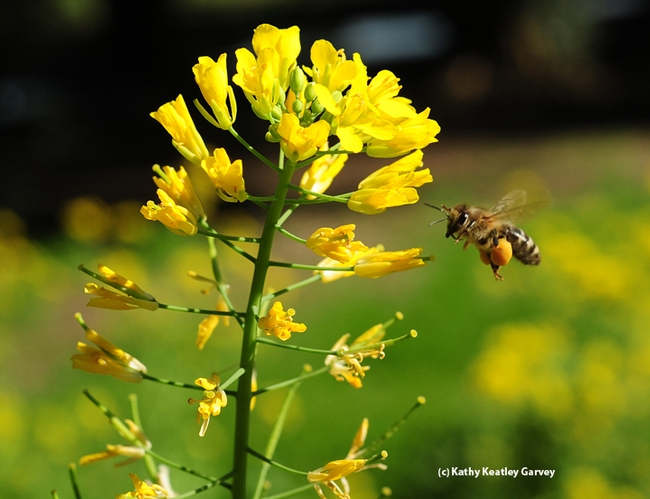
A honey bee heads toward mustard. (Photo by Kathy Keatley Garvey)
Borage: Bee Bread
Borage (Borago officinalis), aka starflower, bee bread. Clusters of sky blue, nectar-rich starflowers grace this Mediterranean annual herb almost continuously through Spring, Summer and Fall. Honey bees and bumble bees can't get enough of it. It has distinguishing black anthers, white prickly hairs and bristly stems and leaves. It is often grown as a companion plant to legumes, strawberries, spinach and brassicas. Full sun, any soil, keeps this plant growing 2-3 feet tall. Keep it dry or provide very moderate water. It reliably reseeds itself year after year.
I placed just one plant in my hard-clay soil a couple years ago. Now, single stems emerge in new spots every Spring. So, be sure you don't mind it popping up just about anywhere it pleases. If you have a small hill or bare area, an empty corner, if you like your garden a little more wild or informal, you will love the bees that head directly to the borage; they will then frequent your garden to explore your other goodies.
Since ancient times, borage has been regarded as having a wonderful effect on mind and body. When the yard is alive with sky blue color and pollinators, it certainly lightens the heart and calms the mind. Great-grandmother's pillowcases may have borne the embroidered likeness of borage. Borage oil is said to have an anti-inflammatory, skin-healing effect and is used in skin products to restore moisture and smoothness. The flowers are edible and, when separated from their calyxes, the corollas can be floated in cold drinks like maraschino cherries or used to garnish salads.
The tender young leaves (which lose their flavor when dried) have a cucumber-like taste and aroma and can be used in salads, herb vinegars and pickling. Its leaves are sometimes used as coolants in drinks and were once widely used as an addition to tankards of wine and cider. They’re still commonly included in recipes for claret cup, a drink that consists of iced claret and a little brandy seasoned with sugar, sliced lemon and the herb leaves. It is suspected that the leaves of borage, steeped in wine, were the mysterious Nepenthe elixir that Homer writes about. Roman historian, Pliny, praised Nepenthe for its ability to drive away melancholy and bring pleasant forgetfulness.
At Mendocino Coast Botanical Gardens in Fort Bragg (http://www.gardenbythesea.org/), not only are there spectacular views of the ocean, there are bees are foraging on the Borage that borders the vegetable gardens. At Luther Burbank's Gold Ridge Experiment Farm in Sebastopol (http://www.wschsgrf.org/luther-burbank-gold-ridge-experiment-farm), it's a sea of Borage.
Check out these bee photos by Kathy Keatley Garvey on UC California Garden Web. Wow! She is awesome.
http://ucanr.edu/sites/gardenweb/?blogstart=7&blogtag=yellow-faced%20bumble%20bee&blogasset=42184
NOTE: The UC Gardeners do not recommend consuming any plant unless you have it identified as edible.
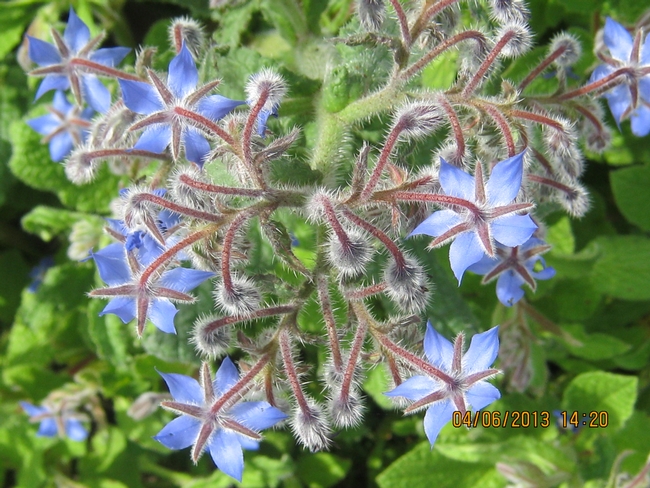
Star-shaped flowers turn pink as they age. (photos by Susan Croissant)
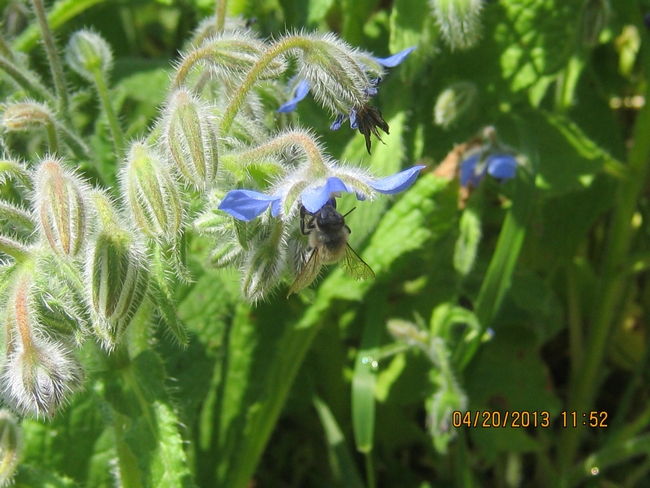
Honey bee on borage.
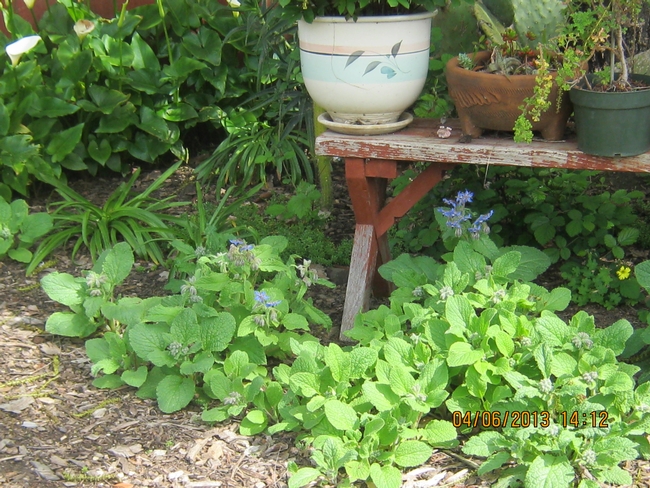
Borage just beginning to pub on flowers.
Edible Flowers
Lately I have been enjoying learning about edible flowers. It started about six weeks ago when two different customers (I am the seed buyer at “Orchard Nursery and Florist” in Lafayette) asked me about seeds for edible flowers. I knew a few of them such as nasturtiums, pansies and chives, but I needed to know more. Fortunately one of the other nurserymen was scheduled to give a class to our customers on the subject which added more to my list. Then there was a great article in the Contra Costa Times on Saturday March 9th, http://www.mercurynews.com/home-garden/ci_22739632/more-homes-flowers-are-moving-from-table-centerpiece and then on April 4th an article was published in the weekly Orchard Nursery Newsletter. Suddenly my “plate” was overflowing with edible flowers!
I looked around my garden and found a number of the listed flowers, so I started using them in salads and as decorations to our dinner plates. First I picked some calendulas and added them to salads. They don’t have much of a taste but they add great color. Then I put a pansy on each plate when I was entertaining friends. The little pansy-faces brightened up the rice dish and added to our conversation. The ones I served had a slight sweet taste, but some are very mild and benefit from salad dressing. Next I used nasturtiums that had over-wintered. They were great in the salad and added a different texture and a peppery taste. I realized I have already been using the flowers of rosemary with a pine-like flavor and thyme which has a lemony flavor, as I combine the two herbs for a meat rub, and sometimes the flowers get mixed in with the leaves.
I’ve heard about using zucchini blossoms and I mistakenly thought if I cut off the blossoms I would be sacrificing the number of zucchini. Not so because the plant produces more male flowers than it needs and it is not hard to identify them with their long stalk winding throughout the plant. The female blossoms, on the other hand, usually grow close to the center and have a stubby stalk that, when fertilized, swells into a mini squash. Some recipes call for using the small squash while the flower is still attached.
As I plant my edible garden this year with tomatoes, cucumbers, beans and squash I will be adding some edible flowers not just for the garden but for our dinner plates. Some easy ones are: Chives with an onion flavor, basil with a lemony minty flavor and borage with a sweet cucumber flavor. I’ll only pick flowers from plants that I know have been grown with no sprays, harmful chemicals, or where dogs or cats run free. Picking flowers for dinner in public areas is not advisable as you have no idea how they were grown and what is on them.
Growing flowers is one thing and knowing how to use them in recipes is another. There are a number of books out, but I find it easier to use the web. A good site with great pictures is http://www.epicurious.com/articlesguides/seasonalcooking/farmtotable/edible-flowers-anise-hyssop
Do you have a favorite edible flower and recipe?
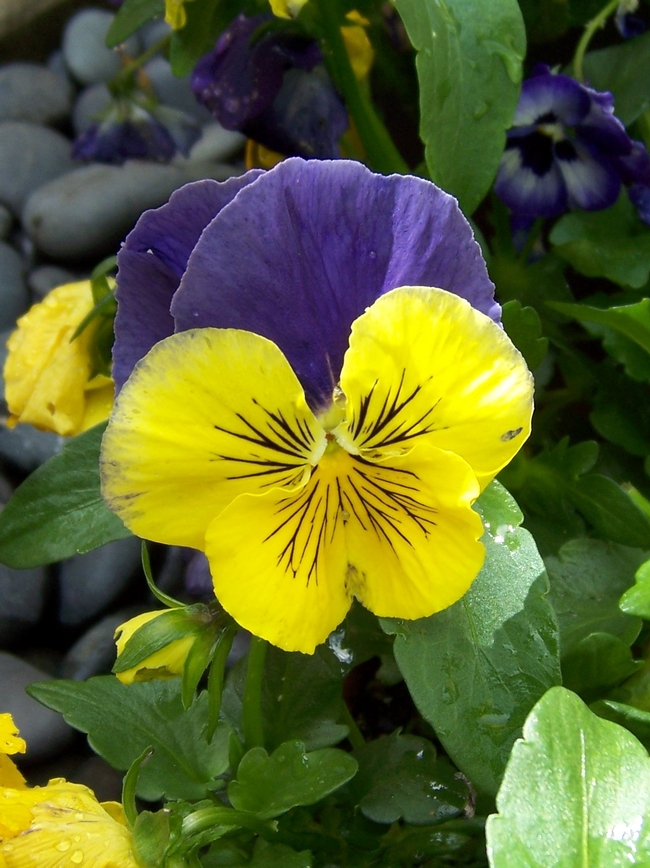
Pansy (photos by Libbey McKendry)
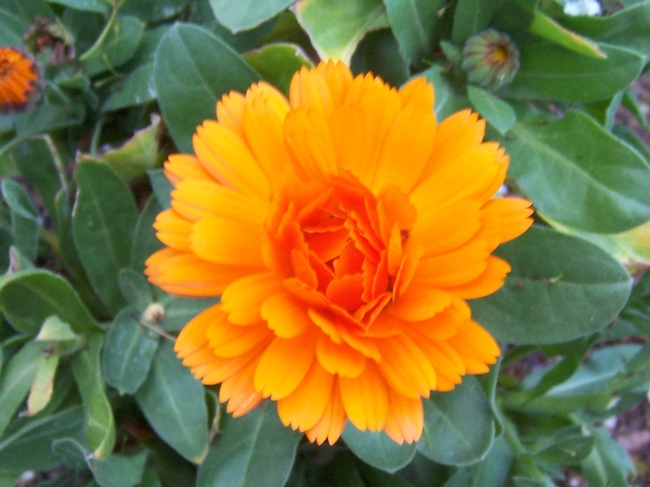
Calendula
A Passion for Butterflies
In September 2012, I wrote about our Passion Flower vine (Passiflora caerulea 'Blue Crown'). I referenced the Agraulis vanillae (Gulf fritillary) butterfly, which has no native host in California and is entirely dependent on the genus Passiflora. Last year we had 4 butterflies. This year we already have 8, and more are on the way. It is awesomely- exciting to discover multiple pupa/cocoons and caterpillars. Here are several photos as well as the fritillary mating on Borage (Borago officinalis).
As I wrote in September, Art Shapiro (butterfly expert and professor of ecology and evolution at UC Davis), says the Gulf frit was first recorded in the Bay Area before 1908 and became "established" here in the 1950s. http://butterfly.ucdavis.edu/node/448
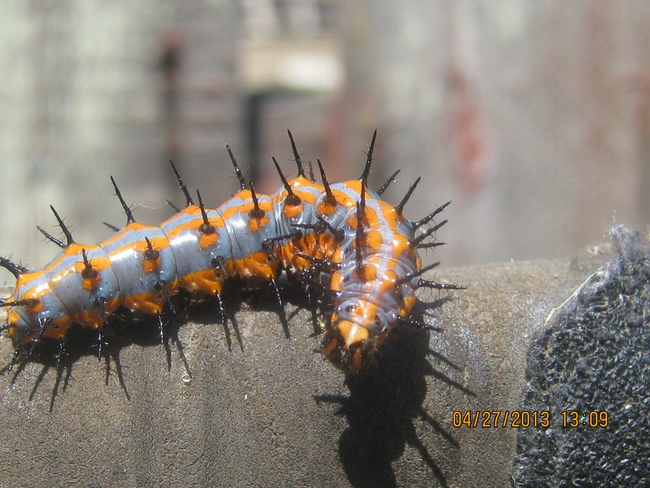
Fritillary caterpillar. (photos by Susan Croissant)
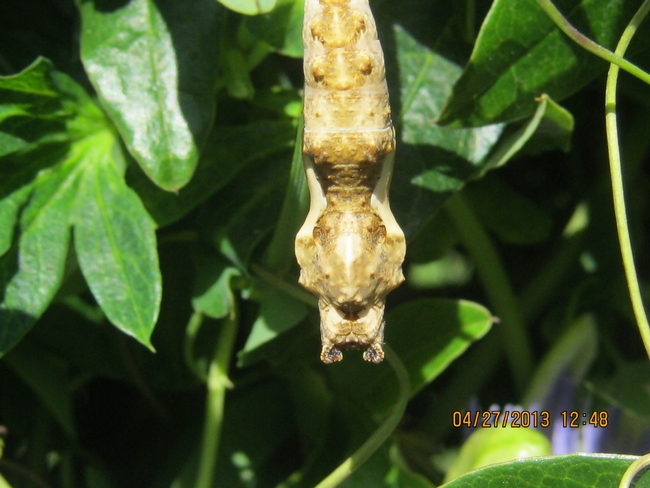
Cocoon.
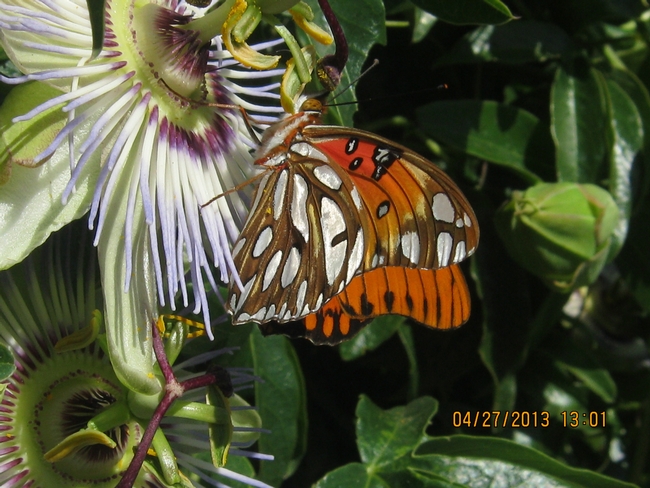
Fritillary butterfly on Passion Flower.
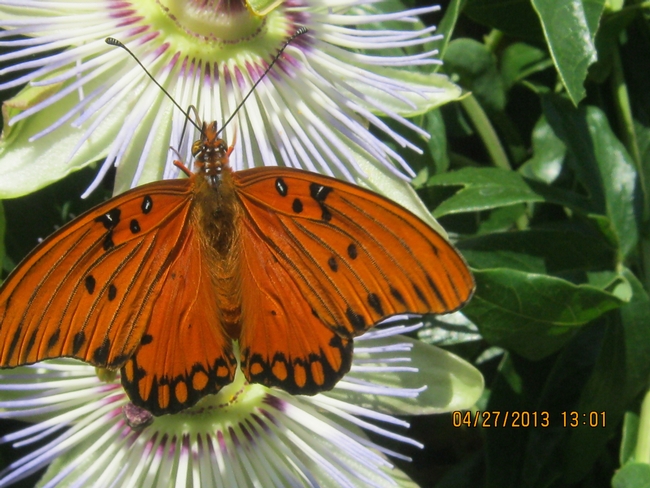
fritillary 2
Blue October
It's "Orange October" for the San Francisco Giants, who just defeated the Detroit Tigers in the opening game of the World Series. But over at the...

Honey bee heading for borage. (Photo by Kathy Keatley Garvey)
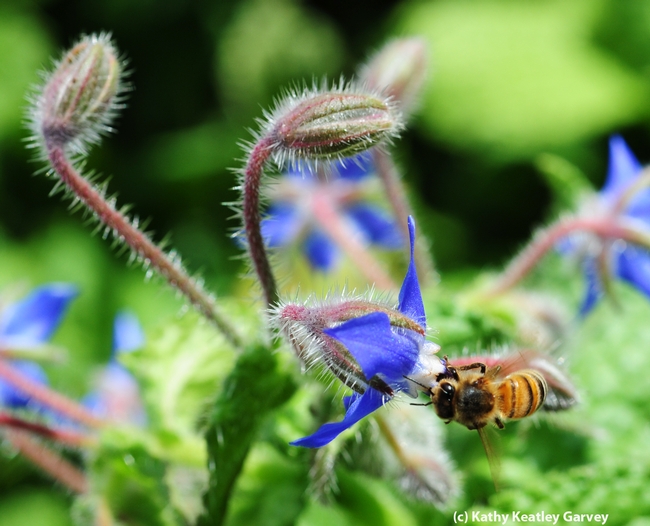
Honey bee foraging among the borage. (Photo by Kathy Keatley Garvey)
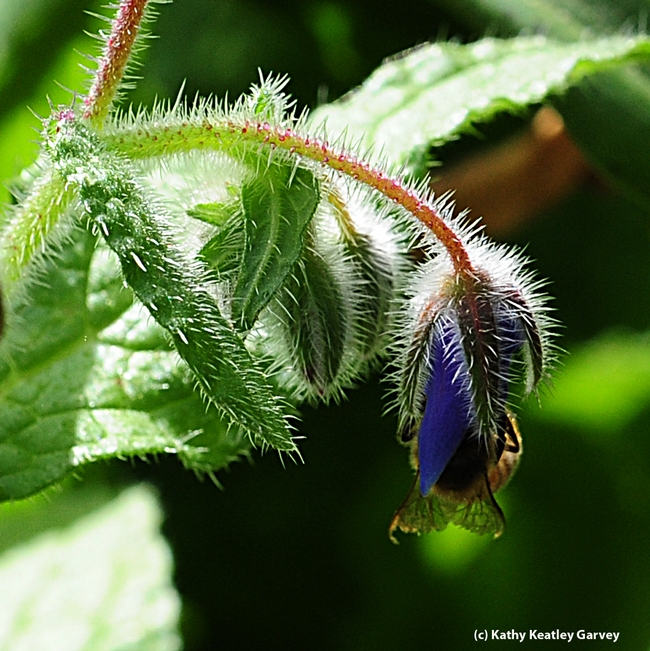
Where's the bee? A borage blossom nearly hides the bee. (Photo by Kathy Keatley Garvey)

